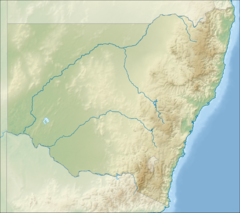Paroo Darling National Park
| Paroo Darling National Park | ||
|---|---|---|
| Sign at the entrance to the park | ||
|
|
||
| Location: | New South Wales , Australia | |
| Specialty: | Dry clay plains and floodplains in the outback | |
| Next city: | White Cliffs , Wilcannia | |
| Surface: | 1,780.53 km² | |
| Founding: | 2000 | |
The Paroo Darling National Park is a national park in the northwest of the Australian state of New South Wales . The park consists of four separate areas in the outback . The northernmost part is in the arid catchment area of the Paroo River east of White Cliffs , the middle part in the area of the confluence of the Paroo River with the Darling River northeast of Wilcannia (including the lakes Peery Lake and Poloko Lake ) and the two western parts in the area west and northwest these two lakes.
The Paroo Darling National Park was formed after the purchase of seven pieces of land in the years 2000-2003 by the government of New South Wales with the help of the National Reserve System Program . The northern part at White Cliffs includes the former sheep breeding stations Arrowbar , Peery and Mandalay . Today the park covers an area of 178,053 hectares.
Peery Lake and Poloko Lake and their adjoining wetlands are part of the Paroo River's floodplain and important to wildlife. When the water level is high, Peery Lake covers 5026 hectares, making it the largest of the Paroo River's floodplains. This lake provides habitat for waterfowl and, when completely filled, holds its water for several years. When the lake is empty, it is the only place in the large artesian basin in New South Wales where springs can be seen on a lake bed.
The park lies in a landscape of gray clay with dry cracks and mountains of red sand along the floodplain of the Darling River.
Aboriginal heritage has been preserved here and shows a lifestyle from many thousands of years ago. You can see fireplaces, stone tools and carved trees that had to leave their bark.
Access to this national park is via unpaved roads from White Cliffs or Wilcannia. The White Cliffs Visitor Center has updated information about the national park.
Camping is allowed on the Coach and Horses Campground at the former Wilga Station approx. 50 km east of Wilcannia.
Web links
Individual evidence
- ^ Steve Parish: Australian Touring Atlas . Steve Parish Publishing Pty. Ltd. Archerfield QLD (2007). ISBN 978174193232-4 . P. 30
- ↑ 2009 Guide to NSW National Parks . NSW National Parks and Wildlife Service
- ^ Paroo-Darling National Park . NSW Environment & Heritage Office ( Memento of the original from June 22, 2009 in the Internet Archive ) Info: The archive link has been inserted automatically and has not yet been checked. Please check the original and archive link according to the instructions and then remove this notice.
- ^ Paroo-Darling National Park - Culture and History . NSW Environment & Heritage Office ( Memento of the original dated August 11, 2008 in the Internet Archive ) Info: The archive link was inserted automatically and has not yet been checked. Please check the original and archive link according to the instructions and then remove this notice.

